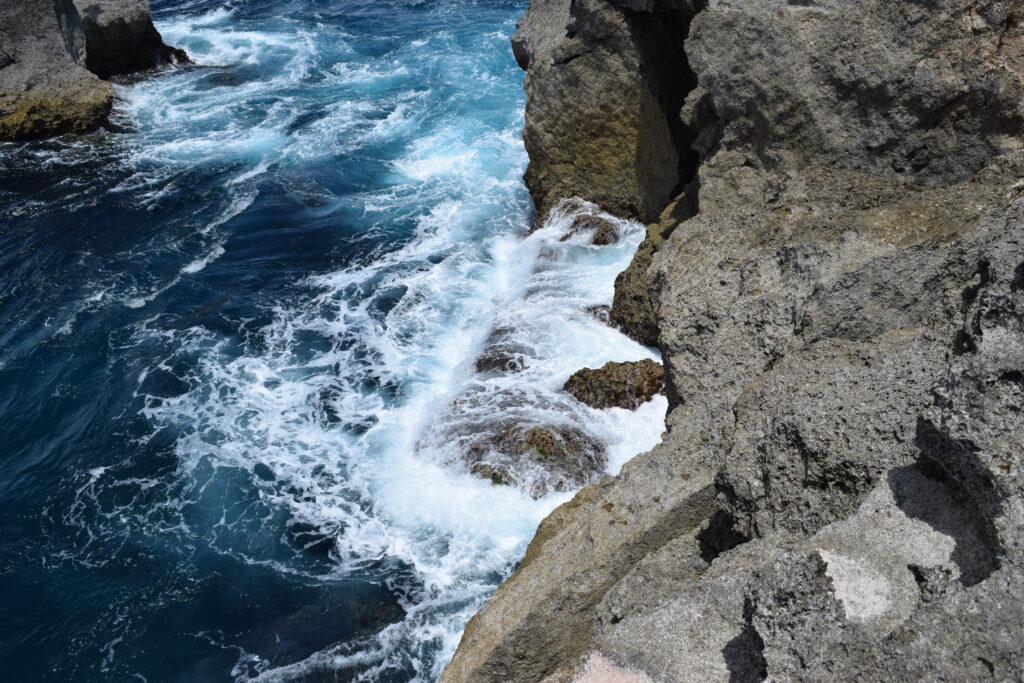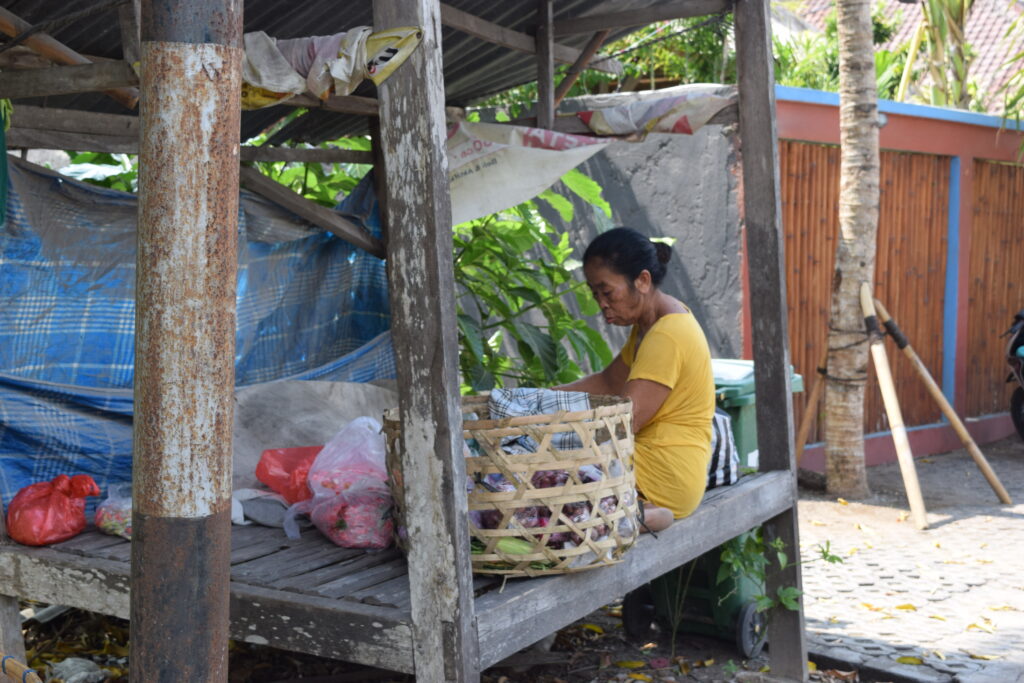
It was early in the morning. The air already felt balmy, the heat of the day only waiting for the sun’s first light to fall over the land below. Its slow rising morphs the sky into shades of blue, purple, orange, and pink. The sand was free for roaming this early. The ropes that usually kept the fishing boats anchored in the sand were nowhere to be seen, as the vessels bobbed in the waves, the owners already hard at work, hoping to bring in a bountiful catch.
I notice an assembly line of people on the beach hauling goods like food and paper, passing it between themselves and onto trucks on the end of the beach, where the road meets the sand. It was this week’s delivery from the main island of Bali. The baskets were brimming with tropical fruits. Sunburnt oranges and ripe pineapples were passed onto shore and would soon make their way to breakfast plates and lunch platters.
Nusa Lembongan is the often-forgotten cousin of Bali. But its quiet pathways, touching mangrove forests, lush greenery, and white sand beaches attract those looking to take a break from the bustle of many Southeast Asian hubs. That is why I was there, to take a break from the high-energy working life in Singapore.
Inaccessible late in the day, thanks to the shifting tide, I board a small speed boat as the sun peeked over the Indonesian skyline on my way to the tiny archipelago of Nusa Lembongan and Nusa Ceningan. Nusa, meaning Island in Indonesian, has a way of carrying you away from the work worries abroad and grounds you on her sandy beaches. On the small carrier boat with me are a group of travelers looking to escape and Indonesians visiting home. I talk to the woman next to me, who shares that she takes this boat every week as she commutes to work between the islands.

Our arrival to Nusa Lembongan was met by small trucks, where we would haul our luggage and ourselves into their open back and embark on roads just wide enough for us. I am dropped off at a small bungalow and greeted by the melody of songbirds who call this island home.
Nusa Lembongan, once a sleepy island, was popularized by surfers searching for a haven away from amateurs and beach resorts. The surf breaks are consistent, and so are the stream of surfers who today hit the waves that crash on the shores. As word of mouth spread of Nusa Lembogan’s perpetually good waves, so did the stream of people and with them, investment in the island. What used to be beach shacks and fireside fish is today a slew of boutique hotels and fine dining restaurants scattered along the beaches and cliffs of this tiny Pacific island. Despite the steam of new investments, Nusa Lembongan remains much quieter than its sister island Bali, offering an easy escape from Bali’s known party scene.


I found myself on the far northwest corner of the island, on the edge of the long white sand beach and the pristine mangrove forests that serve as a natural protector of the island’s integrity from the rising and falling of the ocean’s tides. The mangrove forests on the far end of the islands, where the sea meets the land, were filled with colorful and exotic creatures that painted your view as you slowly moved through the watery tunnels.
The beach is where I meet my surf instructor. A staunch man whose eyes were always on the water. The ocean is as much his home as I would consider mine on land. It’s early; but his enthusiasm to get out on the water is infectious. After suiting up in a wetsuit, our surfboards in tow, we hop into one of the fishing boats heading out to catch a ride to the waves. The men in the boat have no fishing poles or bait, armed only with spears, they will spend the morning free diving in the reef in hopes that their aim and the ocean’s current carry their weapons towards dinner and a few extra dollars at the local wet market.
When we reach the surf break, my instructor and I throw our boards and ourselves into the salty Pacific, leaving behind the fishermen who venture deeper into the ocean’s water. With only the knowledge of surfing from my short beach lesson and, admittedly, a few YouTube videos the previous night, my instructor is pushing me onto the waves. I feel the brutality of the ocean as I fall and am taken under by the waves. Then, I finally conquer one. Albeit, short-lived, I feel as if I have tamed nature and am one with the stream of surfers who made the island a surfing haven.
Successive failures and conquering bring my surf instructor and me back to the sandy beaches of Nusa Lembongan. Walking side-by-side, we stopped to watch another extensive assembly line of people passing goods from a small boat on the shallow shore onto trucks on the end of the beach where the road meets the sand. It’s odd to see another shipment so late in the day. The workers flirt with the tide that will pull the shoreline further out, making it impossible to travel between the mainland of Bali and Nusa Lembongan until the morning. They passed mounds of cakes and fruits. My instructor explained that they were preparing for Nyepi, or as he put it, “Balinese Christmas”.


On the eve of Nyepi, the streets would explode with celebrations. I ventured out early the next morning to watch the final preparations. Walking out from my bungalow tucked in the outskirts of town, I spot a woman nestled underneath a tarp. She braided small baskets from sprouted leaves of the island’s native Pandanus trees. The baskets would sit outside of homes and offerings for good spirits. They were in extra demand this week.
Nyepi is an ancient Balinese holiday, meaning “Day of Silence”. It is a day of reflection and cleansing for the New Year, which follows shortly after. The Hindu Balinese believe that evil spirits roam the Earth, looking for people to torment. So the Balianese, in their cleverness and wit, conjure a plan to trick the demons into leaving them alone.
In the days prior to Nyepi, the Balinese parade the streets. The sounds of bell chimes and drums filled the air as I rode on my small moped into town. I was soon blocked by a caravan of people marching towards the largest Hindu temple on the tiny island. The men, dressed in all white, served as a backdrop to the colorful garments the women wore, all accessorized with rice stuck to their foreheads. Seeing me watch, a local man explained that the rice was a sign of purity and good fortune. The young boys parade large demon-looking puppets and figures called Ogoh-Ogoh. Its purpose – to attract demons and evil spirits to the island.

The temples on the island soon served as an amphitheater for drums and spectacles. While I could not enter, I could feel the energy that leaped from its walls. That night, however, was quiet as the island prepared for a full day of silence tomorrow. Where it is believed that when the demons and evil spirits arrive in the morning, attracted by the sounds and spectacle the days before, will be met with an empty and silent island. Thinking they had misheard, the spirits leave the island, believing there are no humans there. The Balinese, having successfully tricked the spirits, go about in thankfulness as they welcome the new year the next day.
Even as a tourist, I must respect the traditions of Nyepi. I sit on the small porch of my bungalow, unable to leave, and internalize the purpose of Nyepi – reflection, meditation, prayers, and intention setting for the new year that lies ahead.
I think back to the day before, as the celebration marched forward when my eyes caught a group of small children laughing as they weaved between the legs of their elders, hoping a treat would fall from the tops of offering baskets before reaching the temple. I couldn’t help but reflect on my childhood. I rarely left the comfort of the Midwest United States. As of today, I rode homemade motorcycles in southwest France, ate durian in Singapore, and made friends at a hidden alley bar in Bangkok. It was here, in the small streets of Nusa Lembongan, I realized I live a life of adventure. One filled with unequaled experiences and people who open their homes to you. An overwhelming feeling of gratefulness washed over me.
Walking to a waiting speedboat to Bali the next morning, I waved goodbye to the people that welcomed me into their lives. And I waved goodbye to a place of culture and of dreaming. Where locals welcome you into celebration, and songbirds greet you along your scooter ride on the edge of swelling cliffs and crashing waves. And a place where I found peace alone and friendship among strangers.